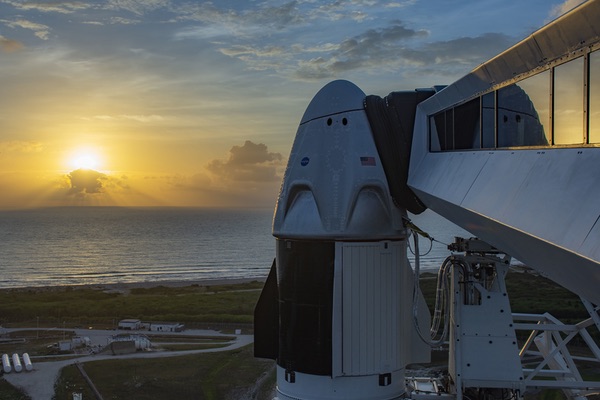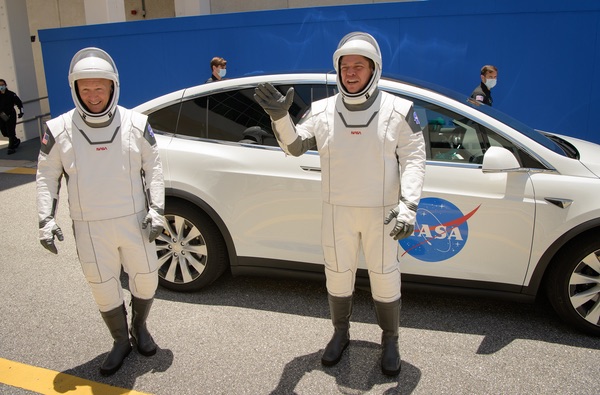Commercial crew’s day finally arrivesby Jeff Foust
|
| “All the teams are go,” said Lueders. “Now the only thing we need to do is figure out how to control the weather.” |
At a brief press availability Friday, the last opportunity for reporters to ask questions of NASA astronauts Bob Behnken and Doug Hurley, one person asked a question of the two: “Bob, what makes Doug a badass, and Doug, what makes Bob one?” The astronauts laughed, but neither of them, nor the NASA public affairs officer moderating the call, wanted to repeat the word on the NASA TV broadcast as they attempted to answer the question.
The leadup to the launch of the Crew Dragon spacecraft on the Demo-2 test flight, with Behnken and Hurley aboard, has been remarkably smooth. Last Friday, NASA and SpaceX completed a two-day flight readiness review for the mission, allowing launch preparations to proceed. Demo-2 cleared a final major hurdle, a launch readiness review, on Monday, ahead of a launch scheduled for Wednesday at 4:33 pm EDT.
“All the teams are go,” said Kathy Lueders, NASA commercial crew program manager, at a briefing after Monday’s review. “Now the only thing we need to do is figure out how to control the weather.”
Weather has emerged as the biggest obstacle to launch. Initial forecasts predicted only a 40% chance of acceptable weather for the launch, although the latest one improved those odds to 60%. But those percentages are only part of the story: unlike a cargo launch of other satellite mission, SpaceX has to account for weather at potential landing zones in the Atlantic Ocean should there be an abort during flight.
The launch weather forecasts don’t take that into account, and SpaceX has been vague about how that’s calculated. “We have a really complicated way of weighing different locations depending on how much risk they have in terms of an escape,” said Hans Koenigsmann, vice president of build and flight reliability of SpaceX, at Monday’s briefing. “It’s a lengthy process to get to the best result.”
Clouds are not the only thing to cast a shadow on the Demo-2 launch. In a move that took the space industry by surprise, NASA announced May 19 that Doug Loverro, the associate administrator for human exploration and operations, whose portfolio includes commercial crew, had resigned, effective the previous day.
The timing, needless to say, couldn’t be worse. NASA didn’t explain why Loverro stepped down, although he told some publications it had nothing to do with the commercial crew program. Speculation is that Loverro violated procurement regulations in some way during the Human Landing System selection process for lunar landers (see “Can NASA land humans on the Moon by 2024?”, The Space Review, May 18, 2020), although neither losing bidder filed a protest. Loverro, in a memo to agency employees announcing his resignation, said he made an unspecified “mistake” but did not elaborate.
| “Charlie Bolden did absolutely magnificent work as NASA administrator at a time when this particular program”—commercial crew—“didn’t have a lot of support in Congress,” Bridenstine said. |
“The risks we take, whether technical, political, or personal, all have potential consequences if we judge them incorrectly. I took such a risk earlier in the year because I judged it necessary to fulfill our mission,” he wrote in that memo. “Now, over the balance of time, it is clear that I made a mistake in that choice for which I alone must bear the consequences.”
A week later, NASA has continued to avoid the subject. NASA administrator Jim Bridenstine appeared at a press conference Friday after the flight readiness review, but ducked out after opening statements; he later tweeted that he was answering questions from members of Congress in a separate videoconference. At a briefing Tuesday morning, just as this article was being prepared for publication, Bridenstine offered lengthy answers on the use of the NASA worm logo or the commercialization of low Earth orbit, but faced no hard questions about Loverro’s departure. (He was grilled, though, on why NASA wouldn’t disclose what Behnken and Hurley would have breakfast on launch day.)
 The Crew Dragon spacecraft atop its Falcon 9 rocket at Launch Complex 39A, awaiting launch. (credit: SpaceX) |
It’s understandable that they focus on the positive aspects of the Demo-2 mission. It is a milestone to finally have a commercially developed (albeit with significant NASA funding) spacecraft finally ready to send astronauts into orbit and bring them back safely. SpaceX overcame problems with the Crew Dragon’s parachutes and the SuperDraco thrusters in its abort system to get to the point where it’s ready to launch astronauts with NASA’s concurrence.
“Last April I probably wasn’t thinking I was going to be flying in a year,” Lueders said at the briefing after the flight readiness review, referring to the SuperDraco explosion in April 2019 that destroyed the Crew Dragon capsule intended for use in an in-flight abort test. Nonetheless, it had its benefits. “That was a real blessing for us. We learned a ton about our system.”
With commercial crew development nearing the finish line after nearly a decade, plenty of people are ready to celebrate, and take credit. On Friday, the White House announced that President Trump will attend Wednesday’s launch attempt, joining Vice President Pence, who previously said he would be there. If Trump is there when the Demo-2 mission lifts off, it will be only the third time a sitting president has attended a NASA launch, after Nixon in 1969 for Apollo 12 and Clinton in 1998 for STS-95, John Glenn’s return to space. (Obama had intended to see the launch of the penultimate shuttle mission, STS-134, in April 2011, but the launch was scrubbed shortly before liftoff because of a technical problem, and he did not return to KSC when the launch took place a few weeks later.)
“Under President Trump’s leadership, we are once again launching American astronauts on American rockets from American soil,” Bridenstine tweeted last Saturday when announcing that Trump and Pence would attend, and then faced criticism from those who noted that the commercial crew program started in the Obama Administration, and had its roots in the COTS program started by the George W. Bush Administration.
Bridenstine, asked about that at Tuesday’s briefing, took pains to credit his predecessor. “Charlie Bolden did absolutely magnificent work as NASA administrator at a time when this particular program”—commercial crew—“didn’t have a lot of support in Congress,” he said. “Charlie Bolden did just yeoman’s work in order to this program off the ground, to get it going.”
But, he added, “the human spaceflight program under President Trump has really blossomed,” citing increased budgets and the new emphasis to return humans to the Moon. “The rhetoric isn’t just there, it’s being backed up with the budget. And it’s bipartisan.”
| “Last April I probably wasn’t thinking I was going to be flying in a year,” Lueders said of the Crew Drago explosion. “That was a real blessing for us. We learned a ton about our system.” |
All those issues about political claims and untimely resignations may be forgotten if the skies clear Wednesday afternoon and the Falcon 9 takes off, placing Crew Dragon into orbit and restoring human orbital spaceflight capabilities to the United States. While full success can’t be declared until the spacecraft safely returns home, up to four months from now, it will be worth celebrating a long overdue accomplishment.
And, for the record: “Doug is ready for anything all the time, he’s always prepared,” Behnken said in response to that reporter’s question Friday. Hurley then said of Behnken, “There’s no stone unturned, there’s no way he doesn’t have every potential eventually already thought about five times ahead of almost anybody else.”
Hurley added: “Bob is the quiet bad—and then I’ll let you put in the next word.” It’s fair to say that, if you’re willing to board a spacecraft making its first flight, you are, by definition, a badass—even if you can’t say the word on TV.
Note: we are temporarily moderating all comments submitted to deal with a surge in spam.
